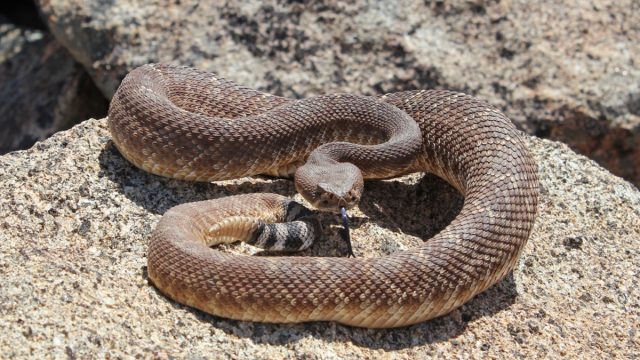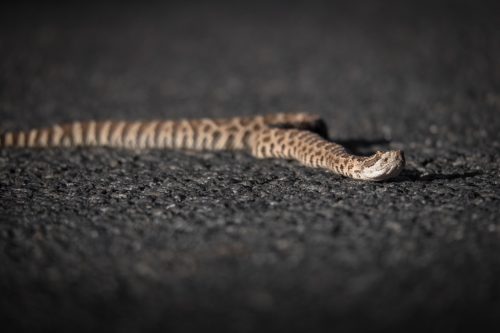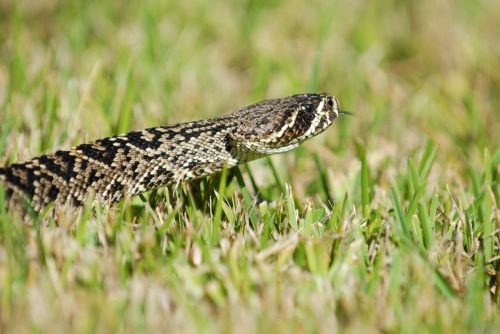10 Rattlesnakes Removed From One Home—Here’s Where They Were Hiding

When you’re out in nature, you generally proceed with caution so as not to disturb (and potentially provoke) surrounding wildlife. Snakes in particular are a species most of us try to avoid, especially deadlier varieties like rattlesnakes, which are the largest venomous snakes in the U.S. But while we’re mindful in the great outdoors, we may also need to be wary at home, as 10 rattlesnakes were just removed from a single residence. Read on to find out where the snakes were hiding, and why officials say these discoveries may become more common.
RELATED: Giraffe-Sized Python Found in the U.S.—Why They’re Unstoppable.
A removal crew relocated almost a dozen snakes.
On Aug. 19, the Golder Ranch Fire District in Pima County, Arizona, shared that they responded to a call for a public assist-snake removal at a local home. In the post on X, the crew shared that they “removed and relocated” 11 snakes in total, including nine baby rattlesnakes, one adult rattlesnake, and one large bull snake.
Per the post, the snakes thankfully weren’t indoors, but were found just outside the home in a “bricked area.” From the photo posted by the crew, it appears the snakes settled in a corner surrounded by potted plants.
RELATED: 17-Year-Old Bitten by Rattlesnake in His Home—Where It Was Hiding.
August is peak season for baby rattlesnakes.

Unlike other snakes, rattlesnakes don’t lay eggs, and the female gives birth to live young after about three months, per the National Wildlife Federation. According to experts, August is the peak time for these births, thanks in large part to the moisture in the air during monsoon season.
After another family of rattlesnakes was relocated in Scottsdale, Arizona, last August, Bryan Hughes, owner of Rattlesnake Solutions, told 12 News that the moisture in the air “is a trigger for those mother snakes to say, ‘Hey, it’s safe to give birth now.'”
Michael Ring, videographer for the Phoenix Herpetological Sanctuary, told NBC-affiliate 12 News that the organization anticipates an increase in calls for rattlesnake removal at this time of year.
“It’s been bringing out all of the reptile life,” Ring said. “There’s finally some moisture in the environment, which is a really big catalyst for rattlesnake movement.”
RELATED: 8 Things in Your Yard That Are Attracting Snakes to Your Home.
Snakes seek a spot to safely give birth.

Hughes previously told 12 News that rattlesnakes will look for a place to birth their young during monsoon season—and that could end up being someone’s home.
“Sometimes they get flooded out or they find something in a home that is a good emulation of where they would give birth in the wild,” he told the outlet last year.
However, Hughes added that this situation is rare. As of Aug. 2022, only about a dozen calls out of 1,000 received by Rattlesnake Solutions each year involve snakes born at homes in the area.
Still, Ring suggests proceeding with caution.
“This is definitely the time of the year where we should be wary of our snakes,” he told 12 News. “Not because they’re dangerous, but because they share this area with us.”
RELATED: For more up-to-date information, sign up for our daily newsletter.
Baby snakes are still venomous.

The University of Arizona notes that rattlesnake babies range in length from six to 12 inches when they’re born, and are “rattleless” until they shed their first skin. As such, they don’t make the typical “chica-chica” warning sound before they strike—and if they do bite a human, they have enough venom to be dangerous.
“The idea that babies are worse is false,” Hughes told 12 News. “But it is still an emergency situation, though—you know that it is typically less dangerous than an adult. You still want to go to a hospital.”
With that in mind, if you do find a rattlesnake in or around your home, it’s best to just leave them be. “Typically, most rattlesnake bites occur when people are trying to injure the snake,” Ring told 12 News.
Experts recommend contacting a professional service that will handle and relocate the snakes to their natural environment.